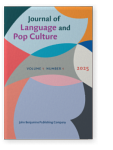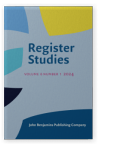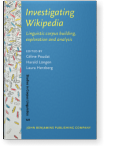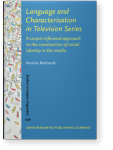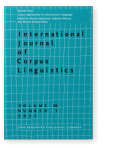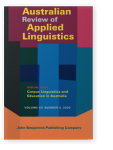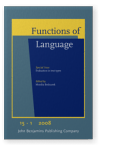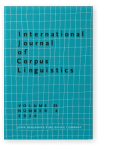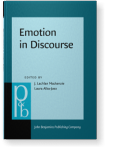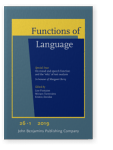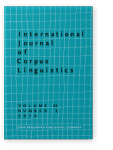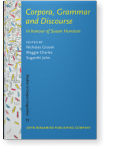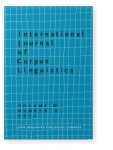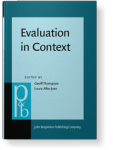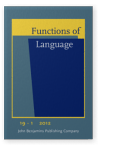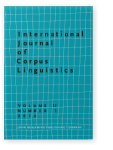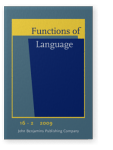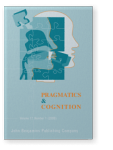Monika Bednarek
List of John Benjamins publications for which Monika Bednarek plays a role.
Journals
ISSN 2950-578X | E-ISSN 2950-5798
Book series
Language and Characterisation in Television Series: A corpus-informed approach to the construction of social identity in the media
Monika Bednarek
[Studies in Corpus Linguistics, 106] 2023. xii, 265 pp.
Subjects Communication Studies | Corpus linguistics | Discourse studies | Pragmatics | Sociolinguistics and Dialectology | Theoretical literature & literary studies
Corpus approaches to telecinematic language
Edited by Monika Bednarek, Valentin Werner and Marcia Veirano Pinto
Special issue of International Journal of Corpus Linguistics 26:1 (2021) v, 160 pp.
Subjects Computational & corpus linguistics
Corpus Linguistics and Education in Australia
Edited by Alexandra I. García, Peter Crosthwaite and Monika Bednarek
Special issue of Australian Review of Applied Linguistics 43:2 (2020) v, 119 pp.
Subjects Applied linguistics | Corpus linguistics | Discourse studies | Language acquisition | Language policy | Language teaching | Multilingualism | Pragmatics | Translation Studies | Writing and literacy
Telecinematic Discourse: Approaches to the language of films and television series
Edited by Roberta Piazza, Monika Bednarek and Fabio Rossi
[Pragmatics & Beyond New Series, 211] 2011. xi, 315 pp.
Subjects Discourse studies | Pragmatics
Evaluation in text types
Edited by Monika Bednarek
Special issue of Functions of Language 15:1 (2008) 192 pp.
Subjects Functional linguistics | Pragmatics | Theoretical linguistics
2021 Corpus approaches to telecinematic language Corpus approaches to telecinematic language, Bednarek, Monika, Valentin Werner and Marcia Veirano Pinto (eds.), pp. 1–9 | Introduction
2020 Keyword analysis and the indexing of Aboriginal and Torres Strait Islander identity: A corpus linguistic analysis of the Australian Indigenous TV drama Redfern Now International Journal of Corpus Linguistics 25:4, pp. 369–399 | Article
This article presents a corpus-driven sociolinguistic study of Redfern Now – the first major television drama series commissioned, written, acted, directed and produced by Indigenous industry professionals in Australia. The study examines whether corpus linguistic keyword analysis can identify… read more
2020 Corpus linguistics and education in Australia Corpus Linguistics and Education in Australia, García, Alexandra I., Peter Crosthwaite and Monika Bednarek (eds.), pp. 105–116 | Introduction
2019 Chapter 2. The multifunctionality of swear/taboo words in television series Emotion in Discourse, Mackenzie, J. Lachlan and Laura Alba-Juez (eds.), pp. 29–54 | Chapter
This chapter focuses on swear/taboo words, which can be used for the expression of emotion. It combines a theoretical with an applied lens, in first discussing their place in Systemic Functional Linguistics, before examining their use in contemporary US television series. To do so, the chapter… read more
2019 Preface On mood and speech function and the ‘why’ of text analysis: In honour of Margaret Berry, Fontaine, Lise, Miriam Taverniers and Kristin Davidse (eds.), pp. 1–4 | Editorial
2019 Kaleidographic : A data visualization tool International Journal of Corpus Linguistics 24:2, pp. 245–261 | Article
Kaleidographic is a dynamic and interactive data visualization tool that allows users to observe and explore relations between any number of variables. The tool is useful for displaying the complex ways in which textual elements interact across a range of texts. Thus far, the tool has been used… read more
2015 Chapter 11. “What we contrarians already know”: Individual and communal aspects of attitudinal identity Corpora, Grammar and Discourse: In honour of Susan Hunston, Groom, Nicholas, Maggie Charles and Suganthi John (eds.), pp. 257–282 | Article
Starting from the assumption that “[e]valuation is personal, private, subjective” (Hunston 2011: 12), this chapter ties evaluation explicitly to the notion of identity. It discusses ‘attitudinal identity’, which concerns positive and negative value judgements and positions, and claims that the… read more
2014 “An astonishing season of destiny!” Evaluation in blurbs used for advertising TV series Evaluation in Context, Thompson, Geoff † and Laura Alba-Juez (eds.), pp. 197–220 | Article
In this chapter I explore evaluation in DVD blurbs (the text on the back of DVD box sets for TV series), which promote television series to potential buyers. The approach taken to the analysis of evaluation is corpus linguistics, and this chapter reports on findings from a pilot study examining the… read more
2012 “Get us the hell out of here”: Key words and trigrams in fictional television series International Journal of Corpus Linguistics 17:1, pp. 35–63 | Article
Based on the analysis of key words and trigrams, this paper explores characteristics of contemporary American English television dialogue. Using a corpus comprising dialogue from seven fictional series (five different genres) and the spoken part of the American National Corpus, key words and… read more
2011 The language of fictional television: A case study of the ‘dramedy’ Gilmore Girls English Text Construction 4:1, pp. 54–84 | Article
This article describes differences in the frequency of words/n-grams in television dialogue as compared with a variety of other corpora. It explores frequent lexico-grammatical patterns in the television series Gilmore Girls, in other fictional programmes, and in unscripted spoken and written… read more
2011 Chapter 10. The stability of the televisual character: A corpus stylistic case study Telecinematic Discourse: Approaches to the language of films and television series, Piazza, Roberta, Monika Bednarek and Fabio Rossi (eds.), pp. 185–204 | Article
This chapter analyses characterisation through television dialogue, using a corpus stylistic (Wynne 2006) approach, in particular using key word and cluster analysis (Scott and Tribble 2006). The focus is on exploring from a linguistic perspective the assumption made in Media/Television Studies… read more
2011 Chapter 1. Introduction: Analysing telecinematic discourse Telecinematic Discourse: Approaches to the language of films and television series, Piazza, Roberta, Monika Bednarek and Fabio Rossi (eds.), pp. 1–17 | Introduction
2009 Language patterns and ATTITUDE Functions of Language 16:2, pp. 165–192 | Article
Interpersonal or evaluative meaning has been described in systemic functional linguistics with the help of appraisal theory (Martin & White 2005), which distinguishes between different types of evaluation. One sub-system of APPRAISAL is ATTITUDE, which is further divided into APPRECIATION,… read more
2009 Dimensions of evaluation: Cognitive and linguistic perspectives Pragmatics & Cognition 17:1, pp. 146–175 | Article
In the past two decades or so, a number of researchers from various fields within linguistics have turned their attention to interpersonal phenomena, such as the linguistic expression of speaker opinion or evaluation (also called stance or appraisal), or the encoding of subjectivity in language and… read more
2008 Introduction Evaluation in text types, Bednarek, Monika (ed.), pp. 1–6 | Article
2008 ‘An increasingly familiar tragedy’: Evaluative collocation and conflation Evaluation in text types, Bednarek, Monika (ed.), pp. 7–34 | Article
Evaluation — the function and usage of language to express the speaker’s or writer’s opinion — has only relatively recently become the object of systematic linguistic research, for example in stance or appraisal analysis. This paper proposes an alternative, corpus-based approach to evaluation… read more

